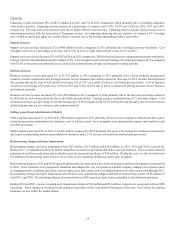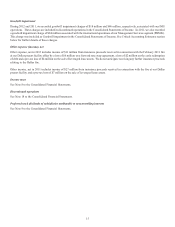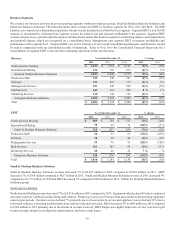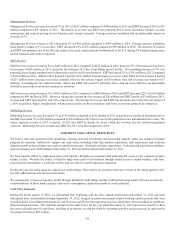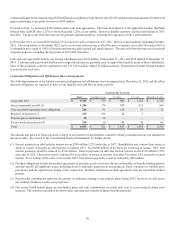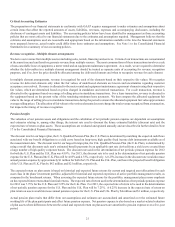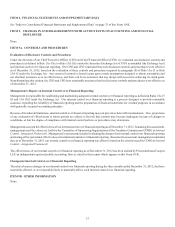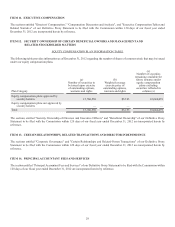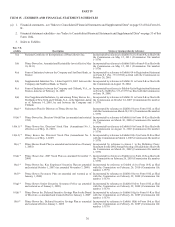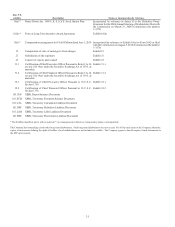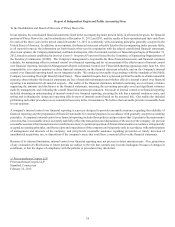Pitney Bowes 2012 Annual Report Download - page 42
Download and view the complete annual report
Please find page 42 of the 2012 Pitney Bowes annual report below. You can navigate through the pages in the report by either clicking on the pages listed below, or by using the keyword search tool below to find specific information within the annual report.24
In 2011, due to the under-performance of our IMS operations, management concluded that it was appropriate to perform a goodwill
impairment review for IMS. We determined the fair value of IMS using a combination of techniques including the present value of future
cash flows, multiples of competitors and multiples from sales of like businesses, and determined that the IMS reporting unit was impaired.
The inputs used to determine the fair value of the IMS operations were classified as Level 3 in the fair value hierarchy. We allocated the
implied fair value to the assets and liabilities of IMS and determined the implied fair value of goodwill. Based on our review, we recorded
a goodwill impairment charge of $46 million and identifiable intangible asset impairment charges of $12 million to write-down the
carrying values of goodwill and intangible assets associated with the IMS business to their respective fair values. These charges are
recorded in discontinued operations in the Consolidated Statements of Income.
Also in 2011, based on the results of our annual goodwill impairment review process, we determined that the international operations of
our Management Services segment (PBMSi) were impaired. We determined the fair value of PBMSi using a combination of techniques
including the present value of future cash flows, derived from our long-term plans and historical experience, multiples of competitors
and multiples from sales of like businesses and allocated the estimated fair value of the assets and liabilities of PBMSi. The inputs used
to determine the fair value of PBMSi were classified as Level 3 in the fair value hierarchy. Based on our review, we recorded a goodwill
impairment charge of $84 million and intangible asset impairment charge of $5 million to write down the carrying value of goodwill and
intangible assets to their respective estimated fair values.
Based on the results of our annual impairment review conducted in 2012, the estimated fair values of our reporting units were substantially
in excess of their respective carrying values, except for PBMSi, whose estimated fair value exceeded its carrying value by approximately
4%. At December 31, 2012, the goodwill allocated to PBMSi was $5 million. The assumptions used to estimate fair value were based
on projections incorporated in our current operating plans as well as other available information. The current operating plans included
significant assumptions and estimates associated with sales growth, profitability and related cash flows, along with cash flows associated
with taxes and capital spending. The discount rate used to estimate fair value was risk adjusted in consideration of the economic conditions
of the reporting unit. We also considered other assumptions that market participants may use. The inputs used to determine the fair value
of PBMSi were classified as Level 3 in the fair value hierarchy. By their nature, projections are uncertain. Potential events and
circumstances, such as declining volumes, loss of client contracts and inability to acquire new clients could have an adverse effect on
our assumptions. We will continue to monitor and evaluate the carrying values of goodwill and intangible assets of PBMSi, and should
actual results differ significantly from our estimates and assumptions, additional non-cash impairment charges for goodwill could be
recorded in 2013.
Stock-based compensation expense
We recognize compensation cost for stock-based awards based on the estimated fair value of the award, net of an estimated forfeiture
rate. We recognize compensation costs for those shares expected to vest on a straight-line basis over the requisite service period.
We estimate the fair value of stock awards using a Black-Scholes valuation model or Monte Carlo simulation model. These models
require assumptions be made regarding the expected stock price volatility, risk-free interest rate, expected life of the award and dividend
yield. The estimate of stock price volatility is based on historical price changes of our stock. The risk-free interest rate is based on U.S.
treasuries with a term equal to the expected life of the stock award. The expected life of the award and expected dividend yield are based
on historical experience.
We believe that the valuation techniques and the approach utilized to develop the underlying assumptions are appropriate in estimating
the fair value of our stock-based awards. If factors change and we use different assumptions, our stock-based compensation expense
could be different in the future. Estimates of fair value are not intended to predict actual future events or the value ultimately realized
by employees who receive equity awards, and subsequent events are not indicative of the reasonableness of the original estimates of fair
value. In addition, we are required to estimate the expected forfeiture rate and recognize expense only for those shares expected to vest.
If our actual forfeiture rate is materially different from our estimate, the stock-based compensation expense could be significantly different
from what we have recorded in the current period.
Restructuring
We have undertaken restructuring actions which require management to utilize certain estimates related to the amount and timing of
expenses. If the actual amounts differ from our estimates, the amount of the restructuring charges could be impacted. On a quarterly
basis, we update our estimates of future remaining obligations and costs associated with all restructuring actions and compare these
updated estimates to our current restructuring reserves, and make adjustments if necessary.


